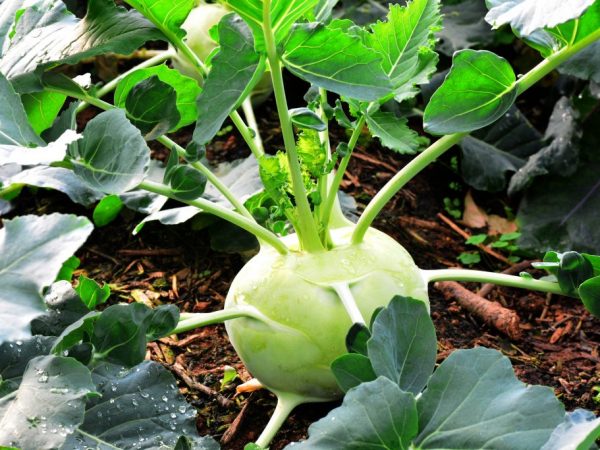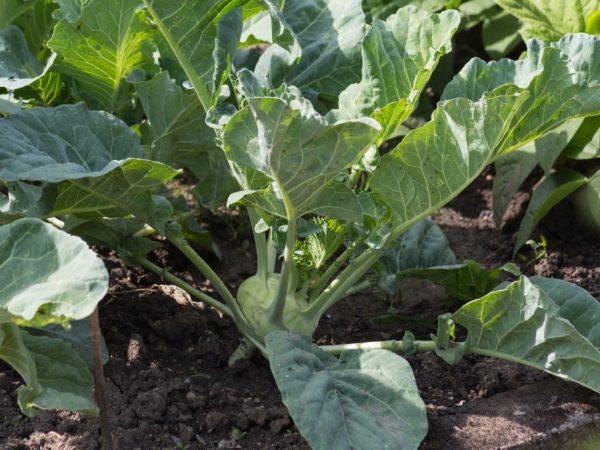Features of growing kohlrabi cabbage
Kohlrabi cabbage is one of the varieties of cabbage. Its main feature is a round root crop. In the article, we will consider how the cultivation of kohlrabi cabbage in the ground should be carried out, the timing of planting, and the basic rules that will allow you to get a good harvest.

Features of growing kohlrabi cabbage
Description of the variety
Kohlrabi cabbage looks somewhat like a turnip. But it tastes like white cabbage, but at the same time it is more juicy. The color scheme of this variety of cabbage is different:
- pale green;
- yellow;
- pink (or purple).
Depending on the variety, the shape is round or slightly flattened, and the weight is from 200 g to 1 kg.
Kohlrabi, the cultivation of which is similar to the earlier white cabbage, yields cabbage crops several times per season. But it is not stored for a long time, so it should be eaten as soon as possible.
There are two ways to grow kohlrabi cabbage:
- through planting seeds in open ground;
- with the help of seedlings.
Seedling cultivation
You can plant kohlrabi cabbage with seedlings - this will allow you to get an early harvest. It is usually grown in greenhouses, greenhouses, boxes and on window sills.
It is better to grow kohlrabi cabbage seedlings on windowsills. This is perhaps the most suitable place in modern apartments and houses. In this case, stem fruits can be obtained already at the end of spring - at the beginning of summer.
Pre-sowing preparation
The agricultural technology of this vegetable involves the preparation of seeds before planting. This will protect the plant from diseases affecting this cabbage variety.
The seeds are placed in a cloth napkin, after which they are kept in hot water for about half an hour. The liquid temperature should be around 50º. After that, the seeds are cooled in cold water for 10-15 minutes. Then the cabbage seeds should swell. To do this, they are left for 12-15 hours at room temperature.
Then the seeds must be placed in the refrigerator or some other cool place. To make them free-flowing and easy to plant, they should be dried. This completes the preparation of the seeds before planting.
Sowing and care
Seeds are planted for seedlings, usually experienced gardeners are planted around mid-March, at 15-20 days. But before planting seedlings in the soil, it must be prepared. For example, the earth must be decontaminated with a solution of potassium permanganate, which will allow the prevention of many diseases.
Growing kohlrabi involves following several rules:
- Be sure to pay attention to the amount of light in the apartment. The optimal daylight hours lasted about 13-15 hours a day. An ordinary fluorescent lamp is suitable for these purposes.
- Watering is necessary as the soil dries: it is not necessary to dry it out, but it is also not recommended to give it too much moisture.
- After each watering, be sure to loosen the soil.
- Until the shoots appear, the temperature in the room should be between 19 and 20º.
Transfer to the garden

Don't forget to water the plants
Kohlrabi cabbage is planted shallowly - exactly as it sat in the nursery. If it is planted a little deeper into the soil, then this will significantly complicate the formation of a stem crop, which will affect the quality of the crop. When planting seedlings in the soil, it is important to remember that young plants can withstand frosts down to -3º.
Seating scheme for kohlrabi cabbage: too close planting inhibits the growth of seedlings, which again negatively affects the future harvest. In this case, cabbage does not receive the required amount of light and air, which does not allow obtaining tender turnips. The optimal area for good seedling nutrition is 25 by 25 cm.
When the seedlings are planted in the soil, it is important to keep an eye on watering. As practice shows, cabbage stems begin to form after the appearance of eight leaves. It is during this period that the vegetable begins to consume a lot of moisture. Therefore, the gardener must water the cabbage evenly. After all, a lack of moisture will lead to drying out of the soil, which means that the turnip can crack. This will significantly impair its taste.
Seed cultivation
It is better to start growing kohlrabi from seeds in the middle of winter.
Sowing seeds is used to obtain a late harvest. Seeds are planted in the open ground of a greenhouse or greenhouse. The technique of growing kohlrabi from seeds outdoors is almost the same as growing its seedlings at home. Crops should be insulated with a covering material.
Soil preparation
The soil in the country should be fertile. Also, the place should be well lit. Be sure to fertilize the soil with fresh manure tincture before planting. Just mix it with a few liters of water and let it sit for 5-7 days.
Putting fresh manure on the soil is not recommended, as this increases the risk of infecting the fruit with parasitic insects.
Kohlrabi is best planted after onions, cucumbers or zucchini.
It is necessary to plant in the early period, before planting tomatoes, vegetable beans and other vegetable crops. Because it will create a shade - it will preserve the tomatoes, tomatoes or beans that have not yet matured. And when they get older, get stronger and grow up, kohlrabi will be removed.
How to plant
If you want to once again protect kohlrabi from insect pests, then experienced gardeners and farmers advise you to do the following. Just plant kohlrabi seedlings next to herbs like basil or hyssop. Perennial onions will also help in the prevention and control of diseases and pests. And, in principle, any neighborhood in the garden with fragrant herbs kohlrabi cabbage will "appreciate" its true worth.
A distance of 20-25 cm between plants and about 30-35 cm between rows is sufficient. This type of cabbage does not need to be planted too deep in the soil, as the fruit will form on the stem.
Care

Good care will increase crop yields
This issue is no less important than planting kohlrabi in the ground. After all, what the harvest will be depends on the care of the plant.
Conditions and recommendations for care after planting kohlrabi in open ground:
- Approximately 5-7 days after planting the seedlings in a permanent place (open ground), it must be fertilized with nitrogen fertilizer. For those who do not know, such a top dressing will increase the growth of fruits, make the roots of the plant stronger, and improve the taste of the vegetable.
- After about 3 weeks, fertilize with fermented organic matter.
- Saturate the soil with a solution of superphosphate and potassium. It is very important to comply with the specified terms of the feeding.
- Another condition is that the plants must be thoroughly watered every 3 days. Especially the kohlrabi needs watering in the process of the formation of a stalk. But do not pour too much water. This can lead to root rot.
- Regularly saturate the soil with oxygen, i.e., loosen it.
- Conduct disease prevention and insect pest control.
Tips from experienced gardeners
And now a few simple, but very important tips for growing a vegetable like kohlrabi cabbage:
- To get a harvest in early summer, it is best to grow several varieties in the garden with varying degrees of ripeness.
- Before sowing seedlings in open ground, harden for 2-3 days. This is best done on the balcony when the air temperature reaches over 10ºC. Open the windows a little at first, gradually decreasing the air temperature. This will allow the plants to get used to the cool ambient temperatures.
- If you want to grow kohlrabi in your garden, but you do not have enough space, then you can plant it along with salad or cucumbers. This will have a beneficial effect on the quality of the crop.
- You can harvest the crop already when the stem grows about 7-8 cm in diameter. Do not let the vegetable overripe - this significantly impairs the taste.
- The gardener should also remember that in late varieties of kohlrabi, the stem grower is less susceptible to the wooding process.
- Plant cabbage along with aromatic herbs (basil, parsley, perennial onions). This will have a beneficial effect on the quality of the crop.
- If you want to store the crop, then the vegetable must be taken along with the roots.
The best varieties
Giant
The giant is resistant to heat and drought, so it feels great in the southern regions of our country. It has a juicy white flesh. The fetus itself can weigh up to 5-6 kg.
Violet
A late variety, it is resistant to frosty weather and can grow to a mass of 1-1.5 kg.
Moravia
The Moravia variety was developed in the Czech Republic. It has a juicy pulp, and the fruit itself can reach a mass of up to 2-2.5 kg.
Athena
The mass of the Atena variety is from 3 to 3.5 kilograms. Their flesh is about the same: juicy and tender. Excellent salads are made from such cabbage.
Vienna
Vienna has a purple hue, the mass of the stem is small - about 1 kg. Despite its good taste, this variety is not stored for a long time and is suitable for fresh consumption immediately after harvest.
Piquant
Piquant is resistant to cracking and practically does not lend itself to the wooding process. Weight is about 1-1.5 kg. Its pulp is especially tender and juicy; it is very good for preparing fresh salads from it.
Delicacy
Frost-resistant variety Delicacy red. It has white flesh, tender and juicy. Fruit weight reaches 2-2.5 kg.
Blue planet
The Blue variety keeps well. This variety is hybrid, with a fruit weighing up to 300 grams. It is not prone to cracking, so it can be stored for a long time.
Conclusion
Growing and caring for kohlrabi cabbage does not require much time from gardeners. Pay attention to the recommendations


